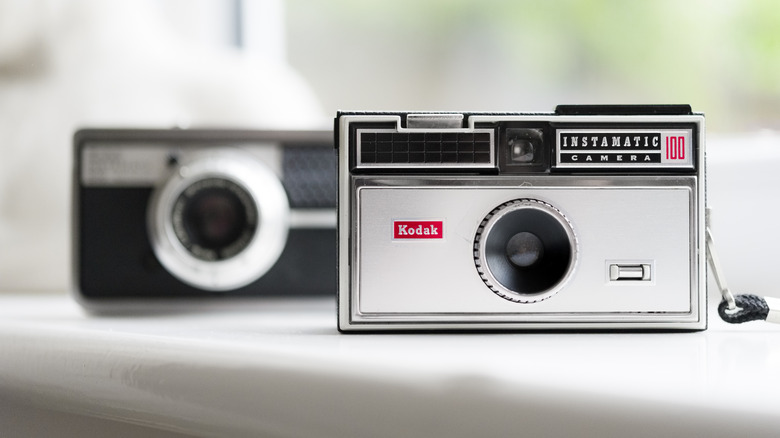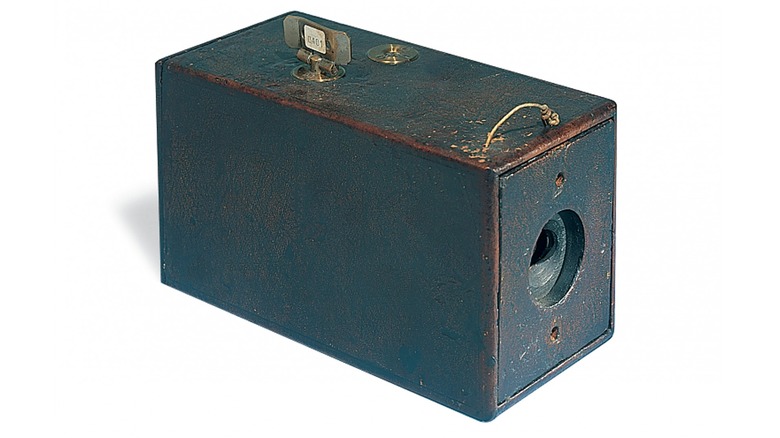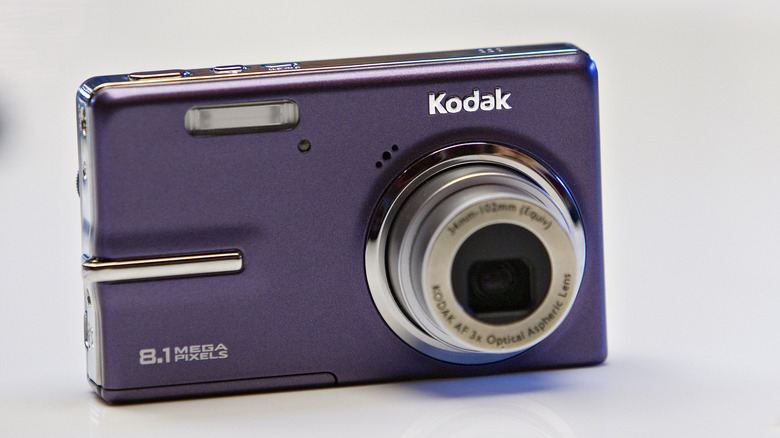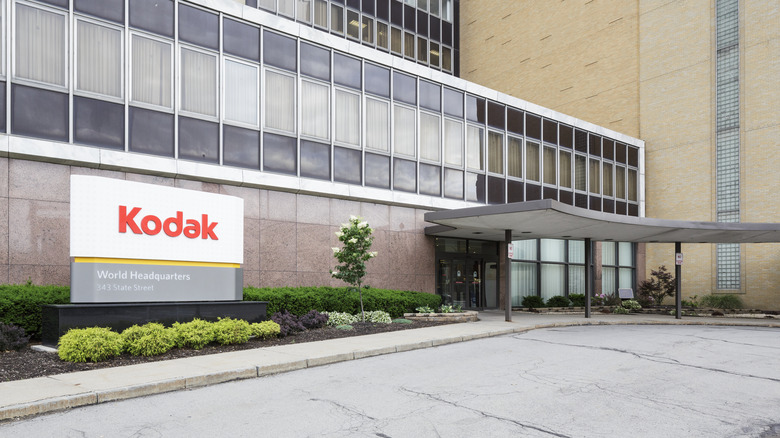Whatever Happened To Kodak?
By all rights, the Kodak brand should have maintained its equity well into the current era. Why wouldn't it? After all, we now live in an age where almost everyone has a camera in their pocket at all times, so why wouldn't the longtime leader in producing film and consumer cameras get in on that action? The phrase "Kodak moment" had long since entered the lexicon as something worthy of being photographed, but even with all of that history, it wasn't enough to save Kodak from bankruptcy.
"It's monopoly disease," business historian John Steele Gordon told ABC News in January 2012. "Whenever you have a monopoly, you get fat, dumb, lazy, and un-innovative."
Kodak still exists in various forms, but many of the products you see with the Kodak name are just less-recognizable companies like Funai Electric licensing the name. If you're 25 years old or younger, you may barely be familiar with the Kodak name in the first place despite its previous near-Kleenex-level ubiquity, so how did it fall so far?
The rise of Kodak
Inventor George Eastman released the Kodak, his handheld roll-film-based camera, in 1888, and it was the first of its kind to find commercial success. It was so successful that with his company becoming so closely associated with Kodak, he changed its name from Eastman Dry Plate and Film Company to Eastman Kodak Company four years later. Essentially, the original Kodak was the first point-and-shoot camera, backed by the marketing slogan "You press the button, we do the rest."
Within a decade, it was estimated that over 1.5 million Kodaks had been sold, revolutionizing amateur photography. The first pocket camera, the Kodak Brownie, followed in 1900, making personal photography even more convenient than it was with the more cumbersome original Kodak, which had to be shipped with the film stock in it so the roll could be developed. As the 1900s ticked by, Kodak was responsible for more and more innovations, like Kodachrome full-color film in 1935, the inexpensive cartridge-based Instamatic in 1963, the first digital camera in 1975, and various other digital innovations in subsequent decades, like 1991's inaugural DSLR.
That initial digital camera in 1975 was a harbinger of things to come, though. Kodak abandoned the project out of fear that advances in digital would jeopardize the company's primary revenue driver, selling film. Even once Kodak started embracing digital in the early 2000s, it stuck with the film-era model of treating cameras as loss leaders, hoping to leverage digital cameras to sell web and printing services, losing $60 on each camera sold.
Meanwhile, Japan's Fujifilm expanded into the U.S. with aggressive marketing in the 1980s. That cut into Kodak's film stock market share such that it filed a WTO complaint, which was rejected in 1998.
Kodak slips in the digital era
As the consumer market — and increasingly much of the professional market — moved away from film in the 2000s, Kodak tried to find ways to pivot. "They want to be the World Bank of Imaging, to offer a Kodak-branded solution for anything you might want to do with images," Citigroup Investment Research analyst Matthew Troy told The New York Times in May 2008. This also meant finding the right segments of the market to abandon: Kodak sold its medical imaging division for $2.35 billion cash in 2007 and officially stopped making Kodachrome color 35mm film in 2009.
With the business changing so much, Kodak's research laboratory shifted towards potential products across all facets of digital imagery, like OLED displays and specialized printers. Consumer electronics companies had eclipsed it in the camera space, with Kodak falling from first place in 2005 to fourth place in 2007 and seventh place in 2010. Meanwhile, existing printer manufacturers like Hewlett-Packard and Xerox beat Kodak to the punch as far as photo printers. This meant that recovery would not come from the "obvious" areas where the Kodak brand name would be expected to shine.
Kodak also started to mine the company's patent portfolio instead of keeping its century-plus history of innovation in-house. At the time of the aforementioned Times article, licensing out various patents was bringing in "well above $250 million" annually for Kodak. The research laboratory was also better integrated into the corporate structure, as the lab staff had largely been left to their own devices for decades instead of having a more regimented, business-first approach.
Kodak goes bankrupt
"If you want to point back to the most pivotal moment that caused this, it was back in 1975 when they discovered the digital camera and put it back into a closet," former Kodak Chief Marketing Officer Jeffrey Hayzlett told Mashable just after the company filed bankruptcy in January 2012. (That's not an exaggeration: Digital camera inventor Steven J. Sasson told The New York Times in 2008 that his Kodak boss's reaction was, "That's cute, but don't tell anyone about it.") "Some of the same people are still there," Hayzlett continued. "I actually had an executive from Kodak come up to me last week and say, 'I think film's coming back.'"
The January 2012 bankruptcy filing was under Chapter 11, meaning that the goal was to allow Kodak to continue functioning and find a way to restructure. Central to the restructuring plan was selling off the company's digital imaging patents, of which it held approximately 1,100, as Kodak leveraged them into a $965 million line of credit so it could continue operating.
Just under a week before the first anniversary of the bankruptcy filing, U.S. Bankruptcy Court Judge Allan Gropper approved the sale of the patent portfolio to patent-holding firm Intellectual Ventures for $525 million. Intellectual Ventures had, in turn, assembled licensing deals with a dozen heavy hitters in the tech world for the patents, including Apple, Google, Microsoft, Facebook, Samsung, Fujifilm, and Adobe.
That was a far cry from the $2 billion the digital patent portfolio had been valued at, but it was the best offer Kodak got. All told the bankruptcy was wrapped up in September 2013, paving the way for a new Kodak. Or Kodaks, technically.
Kodak today
As part of the bankruptcy process, part of Kodak was spun off into a new entity controlled by one of its biggest creditors: Its pension plan in the United Kingdom. This new company, Kodak Alaris, would control Kodak's "Document Imaging" and "Personalized Imaging" businesses, with existing Kodak executives moving to the new company.
"Our excitement around the acquisition of these businesses comes not just from their market strength but from what we see as long-term, highly successful growth opportunities," said pension plan chairman Steven Ross in a statement. "Today starts the new chapter of a storied brand, and we're thrilled with the potential the new company holds for our plan members, our customers, and our employees."
The original Eastman Kodak Company, meanwhile, would focus on the commercial printing and motion picture film sides of the business. With Fujifilm leaving the latter in 2013, it meant the still sizable demand for film stock in Hollywood could only come from one place. That was a windfall for Kodak, which struck long-term deals with most of the major studios in 2020. Also, in 2020, the federal government gave Eastman Kodak a $765 million loan to manufacture ingredients for pharmaceutical products. Though red flags were raised about conflicts of interest in the Trump administration's handling of the deal, an inspector general report cleared the loan a few months later.
In addition, much of what you see in stores with the Kodak name is not made by Eastman Kodak Company or Kodak Alaris, though. The two companies share ownership of the trademarks, which they license out to Funai Electric for the consumer and small office printer and printer consumables business.
Both Kodaks are multi-billion dollar businesses. They're just very different from what they were at Eastman Kodak's peak.




